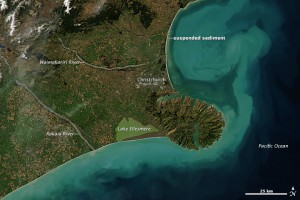by Ellen Stofan
Today I was honored to represent NASA at the Climate Data Initiative launch at the White House. Along with NOAA, Google, and many partners from other government agencies and the private sector, we opened the climate.data.gov gateway with more than 100 curated, high-quality datasets, web services, and tools that can be used by local officials, emergency management personnel and innovators to help communities prepare for the effects of our changing climate change.

The surge of rainfall caused rivers—including the Waimakariri, Rakaia, Heathcote, and Avon—to swell with what appeared to be sediment-rich water. Skies had cleared enough by March 6, 2014, for the Moderate Resolution Imaging Spectroradiometer (MODIS) on NASA’s Aqua satellite to acquire this image showing the aftermath.
For decades, NASA has shown great leadership in assembling a one-stop-shop of space-based Earth science and climate change data. across all disciplines of Earth Systems Science. Given our experience with this type of large-scale data integration, we welcomed the challenge to take on a leadership role in the first phase of the Climate Data Initiative, which integrates government-wide federal datasets across all disciplines that may have an impact on coastal flooding, and to make these datasets easily available.
At NASA, we are working proactively to protect our own national assets along the coasts from the potential impacts of climate change. From Wallops Island, Virginia, to the Space Coast of Florida, we are bringing together our Earth science researchers and our strategic infrastructure managers to provide climate-related decision support in the face of sea level rise and other serious coastal changes. The launch of climate.data.gov opens the door for citizen scientists to get involved in this type of work, in support of coastal communities around the nation.
NASA has a long history of engaging generations of global citizens to use publicly available data to design creative solutions to improve life on Earth, and enable humans to live and work in space. At the Climate Data Initiative launch event, I was delighted to announce that today, NASA and NOAA are together launching a new opportunity for citizens to work with us on this very important topic of coastal flooding.
This coastal flooding challenge is part of NASA’s third International Space Apps Challenge – a two-day global mass collaboration event on April 12-13, 2014. During these two days, citizens around the world are invited to engage directly with NASA to develop awe-inspiring software, hardware, and data visualizations. Last year’s event involved more than 9,000 global participants in 83 locations. This year will introduce more than 60 robust challenges clustered in five themes: asteroids, Earth watch, human spaceflight, robotics, and space technology.
The Coastal Inundation In Your Community challenge is one of four climate-related challenges using data provided by NASA, NOAA and EPA. It invites citizens, students, and all others to create data visualizations and simulations to help people understand their exposure to coastal-inundation hazards. Solutions developed through this challenge could have many potential impacts, including helping coastal businesses determine if they are currently at risk from coastal inundation, and if they will be impacted in the future due to sea level rise and coastal erosion.
I encourage you to roll up your sleeves and get involved in this challenging and energizing event by visiting spaceappschallenge.org.
The Coastal Inundation in Your Community challenge and today’s rollout of coastal flooding data sets are just the beginning. I look forward to the rollout of additional data sets in climate.data.gov, and the opportunity to continue working with this esteemed community of my colleagues at every level of government, our public and private-sector partners and the world’s citizen scientists. And I’m even more also excited about NASA’s upcoming year of major Earth science milestones, including the launch of five missions to study the most important planet in our solar system — ours.
At NASA, we are known for exploring new worlds with rovers on Mars, scientific experiments on the International Space Station, and a vast array of missions exploring our Sun, our neighboring planets and the distant universe. Of all the planets we have explored, none yet have matched the dynamic complexity of our own Earth.
We have a long history of exploring our home planet. For decades we have designed, built, and launched Earth-observing missions to return valuable information about this complex planet we call home. In 2014, we are building on this legacy with five new Earth-observing missions – more than NASA has conducted in a single year in over a decade. These missions will provide global measurements of precipitation, soil moisture, atmospheric carbon dioxide, winds, clouds and aerosols. Your planet is changing. We’re on it.
The author is NASA’s Chief Scientist.
